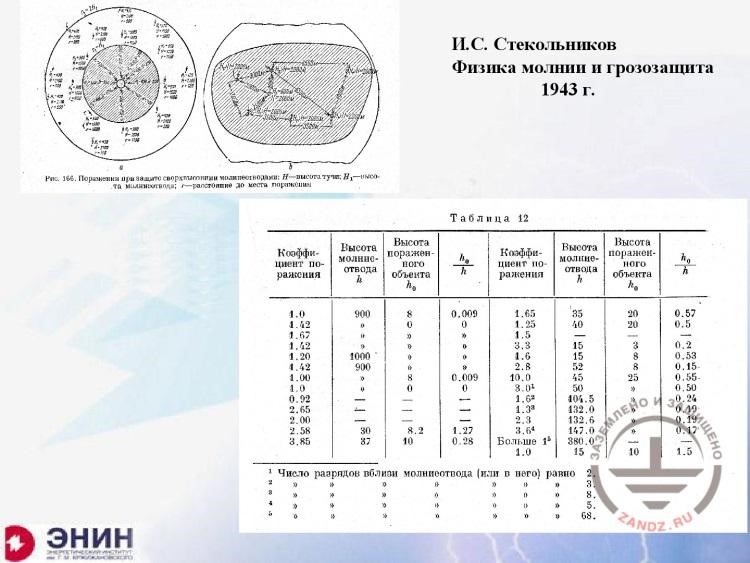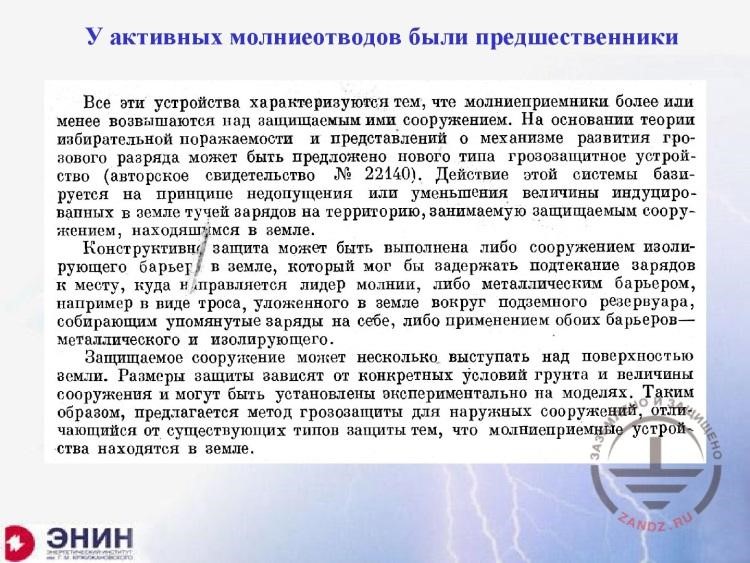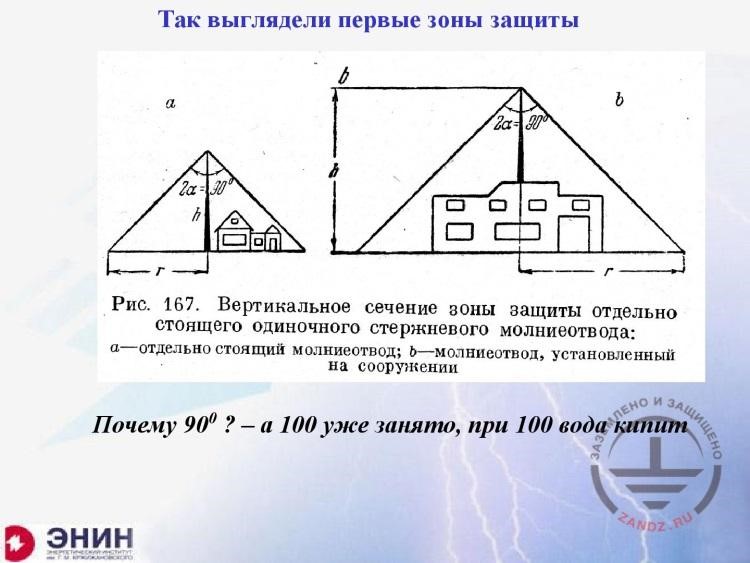The nineteenth webinar of "Earthing and Lightning Protection: Design Issues and Problems" series.
(held on November 22, 2017 at 11:00)
Dress designers are very serious when they say that everything old is new again. When they snip out a piece of cloth, they often peep into old grandmothers' chests to copy the folds, bells, and whistles of the dresses that are stored there. They become original and new. But what do we make in another design when we delineate the protection zones according to the long-forgotten rules? We rarely think about how these zones were obtained and if they are justified. Nobody installed lightning arresters of different heights in an open field to obtain the statistics of lightning strikes to them. What if somebody did? Your life will not be long enough to justify the protection reliability at the level of, e.g., 0.99. As a minimum, you have to observe hundreds of lightning discharges for this, and to do that for the lightning rod of 30 m high, you will need about 1,000 years.
It is not surprising that when the sources of ultrahigh voltage appeared in the middle of the previous century, the researchers tried to simulate the lightning using a long spark. Our country pioneered such research. This way the first protection zones appeared. They were different from those we use today. In those years, nobody thought that, for reliable protection, the lightning arrester should be higher than the facility. The higher it is, the more reliable the protection. The first protection zones protruded from the lightning arrester top, although this fact contradicted both physics and common sense. Moreover, the IEC protection zones have remained like this even today. But they actively promote them to the Russian "scientific" officials.
Interest to the laboratory research of protective effects of lightning arresters re-appeared in the 1970s and it still persists. In those years, we understood that you cannot simulate the lightning using a long spark but we have to try to determine the physical mechanism of the lightning channel orientation. We cannot say that we could achieve this completely, but the general picture became more clear and, on its basis, the computational digital models were generated. Their testing has become a main problem. We had little reliable data. Their major part was collected using the high-class voltage power lines due to the CIGRE efforts. The reliable processing of these data was performed in our country. We already had the statistics of lightning strikes at the Ostankino Tower. Based on it, the lightning arresters with the extreme height were tested.
Thus, the probabilistic method for evaluation of the lightning arrester operating reliability was developed. Its significance is not very high. In the best case, you may count on choosing the lightning arresters with the required reliability of 0.999, although the modern equipment requires even more.
The protection zones in RD 34.21.122-87 and in SO-153-34.21.122.-2003 were also generated using the probabilistic method. But it would have been better to stop using the protection zones. In this case, the specialists have been caught in the traditions. But in fact, the protection zones in the form of conical surfaces that we got used to are not the only ones. We can principally generate zones having completely different configurations. The idea of a protection zone is ambivalent in terms of mathematics, and the actual reliability of the facility protection within its volume cannot be reliably determined. Sometimes, the error exceeds the order of magnitude. Usually, when a specialist designs the lightning arresters according to the protection zones, he or she makes them significantly higher. It means more than extra money today. Unjustifiably high lightning arresters attract more lightnings to the facility, which cause electromagnetic interference. Their impact on modern facilities is often more dangerous than the direct lightning strike itself.
And finally, the most important point. In the best case, the typical protection zones can be generated for two lightning arresters of the same type. But the IEC standard does not provide even this. The protection zones for single lightning arresters are only provided therein. The combined effect of multiple lightning arresters cannot be taken into account by using the protection zones, although, due to such effect, the height of lightning arresters can be significantly reduced while maintaining the required protection reliability. It is impossible to use the protection zones anymore. The sooner the designer takes such decision, the more qualitative his designs will be. All the necessary calculation tools exist and are available today.
720p full screen watching is recommended
Webinar text. Page 1
Fast navigation by slides:
Page 1:
1. Origin of lightning protection zones
2. Protection against the lightning current interference
3. Methods for recording the lightning strike point
4. What was the originators' way of thinking?
5. Protection radius of lightning arresters
6. Research of I.S. Stekolnikov
7. Preceding lightning arresters
8. First protection zones
Page 2: >>
9. Laboratory research in Russia
10. Protection zone according to Akopyan
11. Particular configuration of the protection zone
12. How to determine the protection zone dimensions?
13. Searching for the orientation mechanism
14. Determining protection zones in the laboratory
15. Probabilistic method, ENIN modification
16. Method assumptions
Page 3: >>
17. CIGRE data for high-voltage power lines
18. What problems do protection zones for lightning arresters entail?
19. Multiple lightning arresters
20. IEC shielding angle method
21. What tasks are solved in the laboratory today?
22. Negative spark of 30 m long
23. Report conclusions
24. Questions and answers
Approximate reading time: 1 hour 02 minutes.
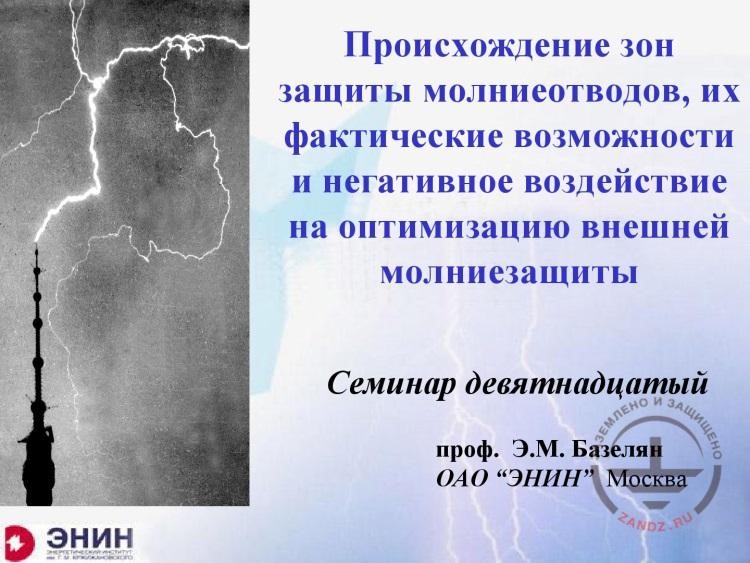
Origin of lightning protection zones
| Происхождение зон защиты молниеотводов, их фактические возможности и негативное воздействие на оптимизацию внешней молниезащиты | Origin of lightning protection zones, their actual capabilities, and negative impact on external lightning protection optimization |
| Семинар девятнадцатый | The nineteenth seminar |
| Проф. Э.М. Базелян | Prof. E.M. Bazelyan |
| ОАО «ЭНИН» Москва | “ENIN” OAO Moscow |
– Good afternoon, dear colleagues! Good afternoon, Eduard Meerovich!
– Good afternoon!
– Let's begin. We are happy to greet you during our next webinar with the participation of professor Eduard Meerovich Bazelyan, the well-known expert in lightning protection and earthing. Our current webinar is titled: "Origin of Lightning Protection Zones, Their Actual Capabilities, and Negative Impact on External Lightning Protection Optimization". Here are some organizational aspects: the webinar will take about 90 minutes, including 60 minutes for the report of Eduard Meerovich, and about 30 minutes for your questions. The questions will be answered at the end of the webinar. I ask you to send your questions eagerly and leave comments in the chat. Moreover, I recommend that, when asking a question, you specify the professor's slide or phrase it relates to, so that it would be easier to understand and to answer it more specifically. In addition to your questions related to this webinar, write subjects and questions you are interested in, in the chat. On their basis, we will schedule and hold our next webinars. Follow this link to get information on the forthcoming webinars. Moreover, you may get information on new events in our social media groups. Join our social media groups or register at the website so that not to miss the relevant events. Dear colleagues! I have finished the introductory word and give my turn to the speaker. Eduard Meerovich, good afternoon!
– Good afternoon, dear colleagues! I am very pleased to see so many participants. I am grateful to the webinar administrators for this subject because I have felt myself an archaeologist for two weeks and have dug into the old books to understand how these protection zones had appeared. Probably I will not start from the ancient times and I will not tell you about the seal skin that the ancient Romans considered to be an excellent means to protect against lightnings.
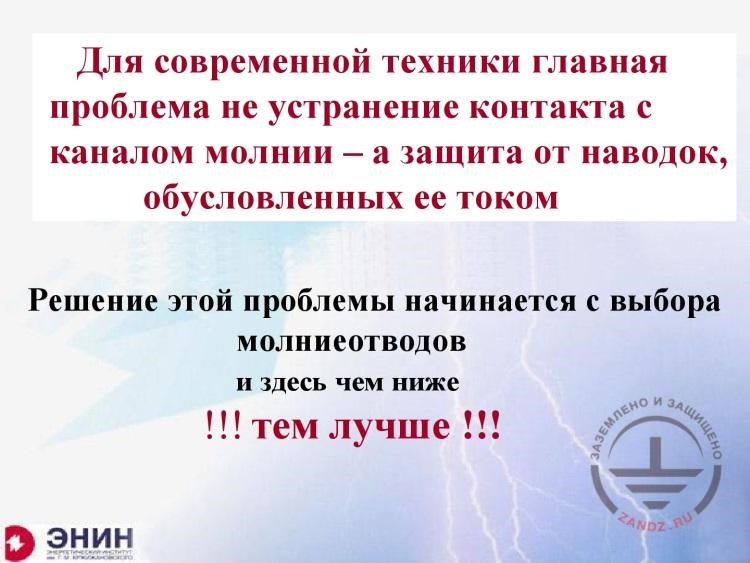
Protection against the lightning current interference
| Для современной техники главная проблема не устранение контакта с каналом молнии – а защита от наводок обусловленных ее током | In case of modern equipment, the major problem is not contact with the lightning channel but rather protection against the interference induced by its current |
| Решение этой проблемы начинается с выбора молниеотводов | Solution of this problem begins with choosing the lightning arrester |
| И здесь чем ниже | And in this case, the lower, |
| !!! тем лучше !!! | !!! the better !!! |
– It was in the past. And now, we have returned to this issue for the following reason: today, we have got a special relationship with the lightning arresters. Few of us bother about the direct lightning strike into a building, but today, the people are more concerned about the electromagnetic impact this lightning induces. And even if the lightning was caught by the lightning arrester, such electromagnetic impact does not disappear. And if we want to protect the facilities through using lightning arresters with a significant height, we will do the following: we will attract those lightnings to the facility to be protected, and their electromagnetic impact may be much more dangerous than the effects from its direct strike. For this reason, today we have returned to the issues of protective action of lightning arresters and to the protection zones. I must admit that I am a vociferous opponent of using the protection zones during the design, and the words I will say today are, to some extent, an effort to show you the imperfection of a protection zone, and what it all results in.
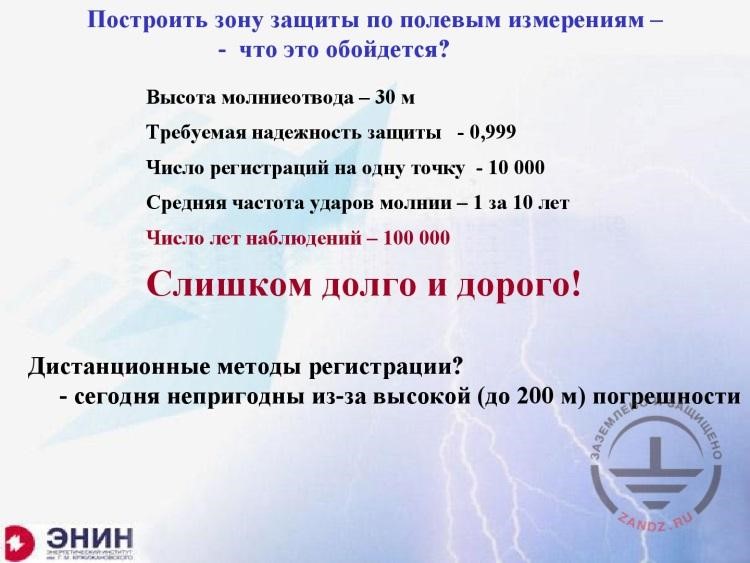
Remote methods for recording the lightning strike point
| Построить зону защиты по полевым измерениям – что это обойдется? | Generating the protection zone based on field measurements: how much will that be? |
| Высота молниеотвода – 30 м | Lightning arrester height is 30 m |
| Требуемая надежность защиты – 0,999 | Required protection reliability is 0.999 |
| Число регистраций на одну точку – 10 000 | Number of records per one point is 10,000 |
| Средняя частота ударов молнии – 1 за 10 лет | Average lightning strike frequency is 1 in 10 years |
| Число лет наблюдений – 100 000 | Number of observation years is 100,000 |
| Слишком долго и дорого! | Too long and expensive! |
| Дистанционные методы регистрации? | Remote recording methods |
| - сегодня непригодны из-за высокой (до 200 м) погрешности | - today, they are not suitable due to high (up to 200 m) error |
– Let's start with the end. I am imagining now that all of us have decided that the protection zones being used today are not very reliable, and we need to design them from the very beginning. What can we do in this case? The answer is simple: let's install a facility or a facility model in an open field, install the lightning arrester thereon and see, how many lightnings are caught by the lightning arrester and what percent of them is got into the facility. Let's hope that we will define the zone with a reliability of 0.999. What can we do for that? To generate a zone with 0.999, you need to have at least one thousand discharges, and out of them, one may get into the facility. To understand, how much of them will break through the protection, there must be 10,000 discharges. If we have got a facility of 30 meters high, and the lightning arrester will have about the same height, then, on average, in Russia, the strike will happen once in 10 years. It means that after 100,000 years, we will have the required statistics. Myself and most of you will not live enough to do this. Therefore, we can do it another way: we can increase the number of facilities to be observed simultaneously. If we have got one thousand facilities, then our experiment will take 100 years, and with 10,000 facilities, we will need 10 years. Generally, it is very expensive. These experiments have not been conducted ever, and, I think, they will never be. You can say: "Dear Eduard, you have forgotten that today we have got remote methods available for recording the lightning strike point, and there are several global companies that sell these systems. You must buy and install them". But it will work out, and the reason is: I contacted such companies many times. We discussed the issue of buying such systems for Russia more than once. But the point is that the accuracy for determining the lightning strike point in the major portion of such systems is about 200 meters. It means that the system cannot differentiate the lightning arrester and the facility. It means that, unfortunately, we cannot rely on the direct experiment on determining the protection reliability.
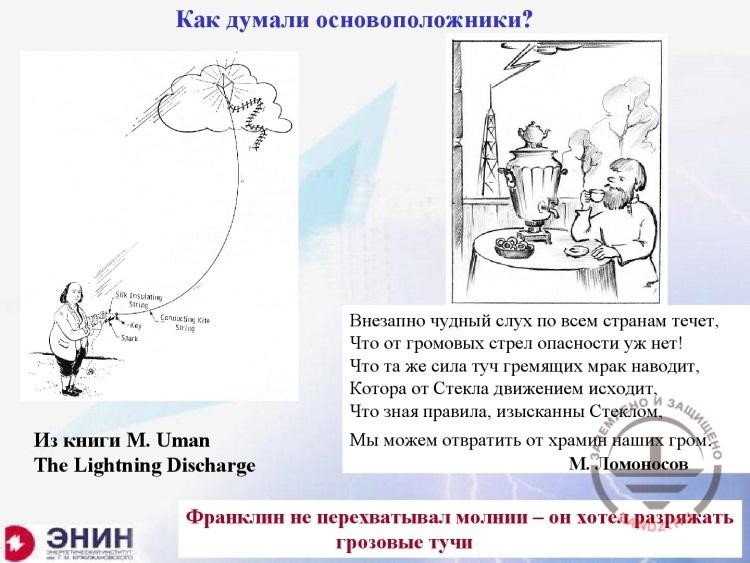
What was the originators way of thinking?
| Как думали основоположники? | What was the originators' way of thinking? |
| Из книги M. Uman The Lightning Discharge | From the book of M. Uman, “The Lightning Discharge” |
| Внезапно чудный слух по всем странам течет, Что от громовых стрел опасности уж нет! Что та же сила туч гремящих мрак наводит, Котора от Стекла движением исходит, Что зная правила, изысканны Стеклом, Мы можем отвратить от храмин наших гром. М. Ломоносов |
Surprisingly, wonderful words have spread across the countries, That there is no more danger from the thunder arrows! That it is the same power that threatens in the clouds, Which is caused by the Glass as it moves, That if we know the rules provided by the Glass, We can take away the thunder from our houses. M. Lomonosov |
| Франклин не перехватывал молнии – он хотел разряжать грозовые тучи | Franklin did not catch lightnings, he wanted to discharge thunderclouds |
– From then onward, let's see into what protection zone is and what we can do with it. You understand that we have to start with Franklin and Lomonosov. Franklin was the first who determined that lightning is an electric charge accumulated in the clouds. He invented a lightning arrester, but he did it from the other end. In general, you know that he wanted to install lightning arresters not to attract the lightning, but he thought that the electric charge that would develop from the lightning arrester would go to the cloud and neutralize the cloud charge, and the lightnings would disappear. To the contrast, the Franklin's system did not work. After some time, it became obvious that the direct function of the lightning arrester is to attract the lightning discharge while taking it away from the facility to be protected. This idea was so brilliant that Lomonosov wrote an ode addressed to Count Shuvalov describing how efficiently the Franklin's lightning arresters were operating.
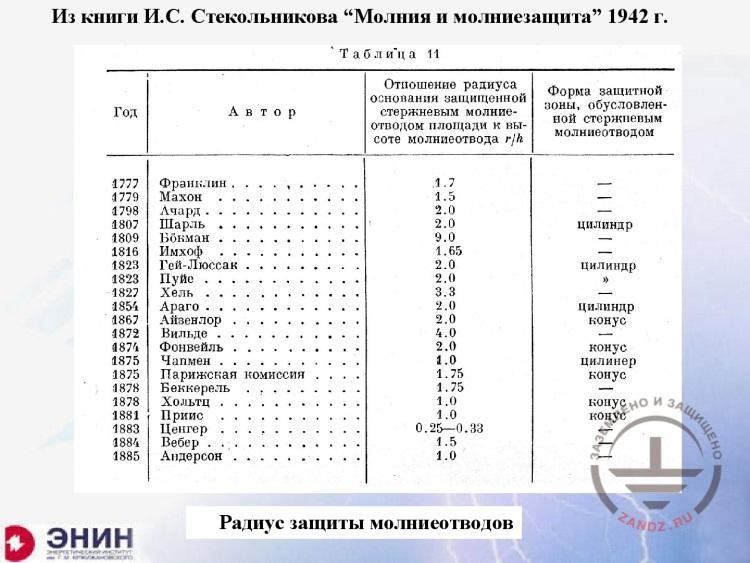
Lightning arrester protection radius
| Из книги И.С. Стекольникова «Молния и молниезащита» 1942 г. | From the book I.S. Stekolnikov “Lightning and Lightning Protection” published in 1942 |
| Таблица 11 | Table 11 |
| Год | Year |
| Автор | Author |
| Отношение радиуса основания защищенной стержневым молниеотводом площади к высоте молниеотвода r/h | Ratio of the base of the area protected by the lightning rod to the lightning arrester height, r/h |
| Форма защитной зоны, обусловленной стержневым молниеотводом | Shape of the protection zone provided by a lightning rod |
| Радиус защиты молниеотводов | Lightning arrester protection radius |
| Франклин | Franklin |
| Махон | Mahon |
| Ачард | Achard |
| Шарль | Charles |
| Бокман | Bockman |
| Имхоф | Imhof |
| Гей-Люссак | Gay-Lussac |
| Пуйе | Pouilles |
| Хель | Helle |
| Араго | Arago |
| Айзенлор | Eisenlohr |
| Вильде | Vilde |
| Фонвейль | Fonveil |
| Чапмен | Chapman |
| Парижская комиссия | The Paris Commission |
| Беккерель | Beckerel |
| Хольтц | Holtz |
| Приис | Priis |
| Ценгер | Zenger |
| Вебер | Weber |
| Андерсон | Anderson |
| цилиндр | cylinder |
| конус | cone |
конус cone
– From this moment on, the second question is arising: if I install a lightning arrester of 10, 20, 30, 100 meters high, what will be its protection zone? From what distance will it attract lightnings? The table you can see is borrowed from the excellent book of my teacher, professor Ilya Stekolnikov, titled "Lightning and Lightning Protection". Please note that it was published in 1942.
| И.С. Стекольников | I.S. Stekolnikov |
| Физика молнии и грозозащита 1943 г. | Physics of Lightning and Storm Protection 1943 |
| Рис. 166. Поражения при защите сверхвысокими молниеотводами: H – высота тучи, H1 – высота молниеотвода, r – расстояние до места поражения | Fig. 166. Strikes with the protection using ultra-high lightning arresters: H is the cloud height, H1 is the lightning arrester height, r is the distance to the strike point |
| Таблица 12 | Table 12 |
| Коэффициент поражения | Strike ratio |
| Высота молниеотвода | Lightning arrester height |
| Высота пораженного объекта | Height of a struck facility |
| Больше | More |
| Число разрядов вблизи молниеотвода (или в него) равно | Number of discharges near the lightning arresters (or into it) is equal to |
– I want to show you one more picture taken from this book. Here is a circle protected by the lightning arrester, and there are the strike points outside the circle. It is interesting what kind of lightning arrester was used there. The lightning arrester was 900 meters high and was installed in the Moscow Region. What do you think, what kind of lightning arrester was it? The lightning arrester was made as air balloons to protect against the German bombers that were flying near Moscow. The researchers observed the protective action of these air balloons and tried to determine the protection zone in such a way. But frankly, it is impossible to make observations without any devices within the radius of about several kilometers. Certainly, it was a speculative research rather than a serious one, but on this basis, they tried to determine the protective action of lightning arresters.
| У активных молниеотводов были предшественники | Active lightning arrestors had predecessors |
| Все эти устройства характеризуются тем, что молниеприемники более или менее возвышаются над защищаемым ими сооружением. На основании теории избирательной поражаемости и представлений о механизме развития грозового разряда может быть предложено нового типа грозозащитное устройство (авторское свидетельство № 22140). Действие этой системы базируется на принципе недопущения или уменьшения величины индуцированных в земле тучей зарядов на территорию, занимаемую защищаемым сооружением, находящимся в земле. | All of these devices are characterized in that the lightning arresters more or less exceed the protected structure. Based on the theory of a selective striking and the ideas of a mechanism of the storm discharge development, a new type of the storm protection device may be offered (author’s certificate No. 22140). The action of this system is based upon the principle of elimination or reduction of the value of the charges in the soil in the territory occupied by the protected structure in the earth, induced by the cloud. |
| Конструктивная защита может быть выполнена либо сооружением изолирующего барьера в земле, который мог бы задержать подтекание зарядов к месту, куда направляется лидер молнии, либо металлическим барьером, например в виде троса, уложенного в земле вокруг подземного резервуара, собирающим упомянутые заряды на себе, либо применением обоих барьеров – металлического и изолирующего. | The structural protection may be designed by either construction of an isolating barrier in the earth that could limit the leakage of the charges to the location wherein the lightning leader goes, or the metal barrier, e.g., as a wire installed in the earth around the underground reservoir collecting said charges thereon, or by use of both barriers, metal and isolating. |
| Защищаемое сооружение может несколько выступать над поверхностью земли. Размеры защиты зависят от конкретных условий грунта и величины сооружения и могут быть установлены экспериментально на моделях. Таким образом, предлагается метод грозозащиты для наружных сооружений, отличающийся от существующих типов защиты тем, что молниеприемные устройства находятся в земле. | The protected structure may protrude slightly over the earth surface. The protection dimensions depend on particular soil conditions and dimensions of a structure and may be determined experimentally on models. Thus, a method of ground protection is offered for the external structures, differing from the existing types of protection in that the lightning arresters are located in the earth. |
– I have provided this extract from the book to show that, more than 50 years ago, active lightning arresters were proposed, and it was suggested to protect the facilities by placing them into the isolated bin made of concrete, which should have had to protect them from the direct lightning strikes. Surely, such protection as well as currently available active lightning arresters do not operate, but there were such proposals.
| Так выглядели первые зоны защиты | This is how the first protection zones looked like |
| Рис.. 167. Вертикальное сечение зоны защиты отдельно стоящего одиночного стержневого молниеотвода: a- отдельно стоящий молниеотвод; b – молниеотвод, установленный на сооружении |
Fig. 167. Vertical cross-section of the protection zone of a standalone lightning rod: a – standalone lightning arrester; b – lightning arrester installed on the structure |
| Почему 90°? – а 100 уже занято, при 100 вода кипит | Why 90°? Because 100 degrees are used, it is the water boiling point. |
– When did their use begin? It began in the moment when the high-voltage sources appeared. When pulse generators appeared that could provide a voltage of at least one million volt, and when we could break through the distance of 1 to 2 meters by applying this voltage. From this moment on, the following idea occurred: "Let's install a model of a lightning arrester and a model of a facility in the laboratory. Instead of lightning, we will have a spark of 1–2 meters, and we will see how this spark will strike the facility". The first experiments of this kind began in the Soviet Union in the 1930s. In the beginning of the 30s, the protection zone was invented which was then represented as a cone starting from the lightning arrester top, and the sides of such cone were angled at 90º. When I tried to understand why the angle of 90º was used, I could not find any explanation except for one: 100 is already used because it is the water boiling point, and 90 is not used, so they took 90º. It was the first protection zone. And the protection zones are based on such "serious" grounds.
Next page >>
slides from 9 to 16
Related Articles:


 Lightning Protection of Large Territories: Parks, Grounds, Plant Territories. Page 1
Lightning Protection of Large Territories: Parks, Grounds, Plant Territories. Page 1
 Lightning Protection of Large Territories: Parks, Grounds, Plant Territories. Page 2
Lightning Protection of Large Territories: Parks, Grounds, Plant Territories. Page 2
 Lightning Protection of Large Territories: Parks, Grounds, Plant Territories. Page 3
Lightning Protection of Large Territories: Parks, Grounds, Plant Territories. Page 3


